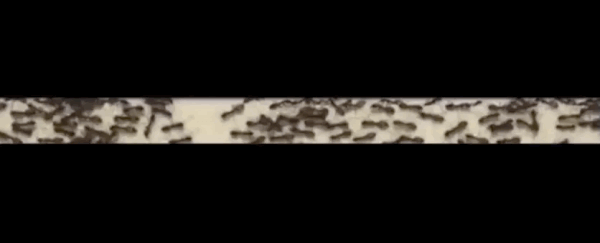To be an ant is to never get stuck in traffic. It's one of the many perks (along with super-human strength, an armour-like skeleton and two stomachs, of course).
As these tiny disciplined creatures march along their narrow pheromone-lined roads, they somehow manage to keep a smooth flow going back and forth, even during rush hour.
By cooperating in a self-organised system, researchers have found that Argentine ants (Linepithema humile) can adapt to different road conditions and prevent clogging from ever occurring. All it takes is a little selflessness and restraint - something we humans should maybe consider.
Along with our own species, ants are some of the only creatures on Earth that move along roads which flow in both directions. So what have these colonies figured out that we haven't?
Sure, ants don't have road rules like we do, and they're not exactly afraid of collisions, but even still, their ability to avoid bunching up by moving as a single unit, kind of like a liquid, has fascinated us for centuries.
Even Aristotle was marvelling at how individual ants "come back to their nest by following a rather straight line and on the path they do not hinder one another".
Previous studies have shown that ant roads can flow at several hundred individuals per minute, but this study is the first to find direct evidence that even at high densities, traffic jams are avoided.
Filming 170 repeat experiments, researchers observed how this particular species of ant moved along a bridge between their nest and a food source. The experiments included different widths of bridge (5 mm, 10 mm, and 20 mm), holding anywhere between 400 and 25,600 ants.
Throughout the process, data was collected on traffic flow, the speed of the ants, and the number of collisions that occurred.
What the authors found was surprising: these ants appeared to be immune to traffic jams.
"The exact nature of the mechanisms used by Argentine ants to keep the traffic flowing in this study remains elusive," they write, "yet when density on the trail increases, ants seemed to be able to assess crowding locally, and adjusted their speed accordingly to avoid any interruption of traffic flow."
In fact, compared to humans, these ants could load up the bridge with twice the capacity without slowing down. When humans are walking or driving, the flow of traffic usually begins to slow when occupancy reaches 40 percent. Argentine ants, on the other hand, show no signs of slowing, even when the bridge occupancy reached 80 percent.
And they do this through self-imposed speed regulation. When it's moderately busy, for instance, the authors found the ants actually speed up, accelerating until a maximum flow or capacity is reached.
Whereas, when a trail is overcrowded, the ants restrained themselves and avoided joining until things thinned out. Plus, at high density times like this, the ants were found to change their behaviour and slow down to avoid more time-wasting collisions.
"Traffic jams are ubiquitous in human society where individuals are pursuing their own personal objective," the authors explain. "In contrast, ants share a common goal: the survival of the colony, thus they are expected to act cooperatively to optimise food return."
Other research on ants has shown that, at times, they even use traffic control 'officers'. In 2008, for instance, scientists found that when an ant trail started to clog, individuals returning to the nest blocked the leaving ants, forcing them to find a new route.
Obviously, humans are more difficult to sway and we don't always behave so logically. While ants spread out evenly over lanes, even in emergency situations, humans are more likely to trample each other in our own urgent desires.
Yet even without changing our own behaviour, there's something to be learned from ants, the authors say. With self-driving cars on the horizon, perhaps we can figure out a way to emulate their strategies and optimise traffic flow.
If we can make our roads more like ant trails, imagine how much more efficient the world would be.
The study was published in eLife.
